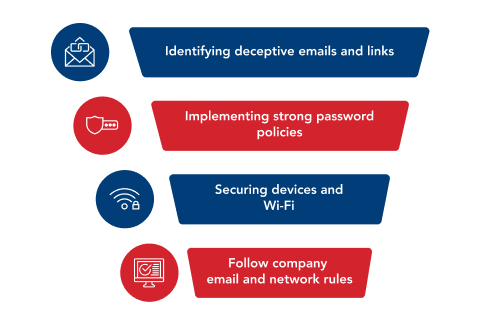There’s no safety-in-size advantage against cybercrime. Attackers often tailor methods based on perceived defenses. SMBs are usually seen as easier targets.
SMBs face higher rates of social engineering attacks or attacks exploiting less sophisticated defenses, while large enterprises might face more Advanced Persistent Threats (APTs).
Yet, without enterprise-level defenses, SMB vulnerability skyrockets. What’s the real-world impact? Cybersecurity services providers warn of immediate costs like forensic investigations combined with long-term reputation damage that can collapse customer trust.
This guide cuts through complexity to build a cybersecurity strategy for small businesses using practical fundamentals:
- Implement automatic system updates to eliminate known vulnerabilities.
- Create unique, strong passwords protected under multi-factor authentication.
- Backup critical data redundantly—locally and in secure cloud storage.
We’ll break down each component into actionable steps tailored specifically for resource-conscious business owners because cyber resilience shouldn’t require an IT department. Keep reading for implementation roadmaps, myth-busters, and NIST-aligned best practices.
Why Personalization Matters for SMB IT & Security
Conventional wisdom about cybersecurity often misses the specific reality facing SMBs—there’s no one-size-fits-all shield. To build effective cybersecurity strategies, small business owners don’t require complex formulae, just a clear-eyed assessment of their unique vulnerabilities.
Start by conducting a basic security risk assessment tailored to your environment. Think of it as mapping your digital terrain to find potential weak spots hiding in plain sight.
This involves looking at three critical coordinates:
1. Your Digital Assets
What data is vital for operations (customer lists, financial records, IP)? Where does this asset inventory reside—on local devices, in cloud services, or personal employee devices (BYOD)?
2. Relevant Threats
How could your specific business be targeted? Common threats include:
- Deceptive phishing emails
- Destructive malware
- Costly ransomware
- Risks from Supply chain attacks via connected third-party services.
3. Overlooked Vulnerabilities
What weaknesses might be missed? Consider:
- Unsecured Wi-Fi
- Weak passwords
- Reliance on outdated legacy systems still running critical functions
- Inadequate physical security for devices
With this map, the next crucial step is risk prioritization. Identify which data loss would be most damaging and which systems are indispensable. This clarity allows for effective resource allocation, focusing protection where it matters most before an incident occurs.
Understanding these unique needs forms the foundation of a resilient defense. Now that you’ve identified your specific risks, let’s look at building the practical measures to counter them.
Also Read: Why SMBs Should Adopt an Enterprise Mindset in Cybersecurity
Implementing Foundational Security Measures for Your Business
A strong cyber hygiene routine begins with core elements that protect daily operations. There are four pillars that every small business cybersecurity strategy requires to guard networks and data. Let’s simplify these critical defenses that balance simplicity and effectiveness.
Step 1: Deploy Your Digital Perimeter Guard
Activate firewall protection to filter inbound traffic like a vigilant gatekeeper. This network security tool blocks malicious access attempts – your first line of defense. Most operating systems include built-in firewalls. Enable yours today through simple device settings.
Step 2: Patch Security Gaps Automatically
Hackers exploit outdated software faster than ever. Most breaches trace back to unpatched vulnerabilities. Set systems to auto-update, closing security holes before criminals squeeze through. Regular patching proves easier and cheaper than breach recovery.
“But aren’t data backups complicated?” Not with the 3-2-1 blueprint. Maintain three data copies across two storage types, including off-site cloud storage. Reliable backups turn ransomware ultimatums from crisis to inconvenience, enhancing data security. Test recovery monthly to verify readiness.
Now that core protections are active, sustained vigilance preserves their value, which we’ll explore in practical terms ahead.
Empower Your Team Through Security Awareness and “Nationwide Expertise” Advantage
Even the most advanced security technology has limitations; your employees are the frontline defence against cyber threats. Educating your team consistently is vital because social engineering attacks, like deceptive phishing emails asking for urgent action or sensitive data, remain a top threat.
Effective security awareness training doesn’t need to be complicated or time-consuming. We focus on practical, bite-sized learning that integrates into daily work routines. Key areas include:
Recognizing Phishing
Training your team to spot fake sender addresses, urgent demands, and suspicious links before they click. Regular, bite-sized sessions—even 10-15 minutes monthly—are more effective than overwhelming annual seminars. Consider adding occasional phishing simulation tests to help solidify learning and gauge understanding.
Password Security
Moving beyond simple passwords by implementing strong password policies and using secure methods to manage credentials.
Safe Device Use
Ensuring laptops and mobile devices are secured through practices like screen locking, safe Wi-Fi use (especially for remote work), and keeping physical devices secure.
Acceptable Use
Clarifying rules for using company email and networks safely.
Consider interactive phishing simulations or creating simple, one-page guides for key policies, like identifying suspicious emails or password best practices. Furthermore, clear policies provide essential guardrails. Examples include:
- An Acceptable Use Policy for the Internet and email.
- A Remote Access Policy outlining secure connection rules.
- Guidelines for reporting suspicious activity immediately.
- Device security (locking screens, securing laptops).
- Remote access (especially using VPNs if applicable).
- Acceptable use of company resources and networks.
You gain access to broad threat intelligence gathered from a nationwide network, benefit from security models proven across diverse industries, and receive strategic insights often reserved for large enterprises. This combination strengthens your local defense and overall cybersecurity strategy for small business needs.
By empowering your team with knowledge and reinforcing it with clear policies and expert support, you build a more resilient security posture from the inside out.
Next, let’s explore how to prepare for the unexpected with incident response planning.
Preparing a Simple Incident Response Outline
No business is immune to cyber incidents, but a basic plan can drastically reduce downtime and damage. Without a playbook, chaos ensues during a data loss event, costing valuable time and money. Think of an Incident Response Plan (IRP) as your emergency protocol for digital crises, a core part of your overall cybersecurity strategy that a small business needs.
Here’s a simplified approach focusing on immediate actions:
Identify the Incident
Recognize signs like ransomware messages, unusual system slowness, or suspicious emails demanding credentials. Train staff on what to look for.
Contain the Damage
Immediately isolate potentially compromised devices from the network. This means physically unplugging network cables or disabling Wi-Fi. Quick containment stops threats from spreading further.
Engage Expert Help
Have contact information readily available for your IT support. Knowing who to call ensures that professional help is engaged quickly. Their expertise is crucial for eradication and recovery.
Recover Operations
Utilize your data backups to restore systems once the threat is neutralized. This step underscores the importance of regular, tested backups.
Your simple IRP should be written down and easily accessible, maybe even as printed cards or via a mobile solution, not just stored on the network that might be compromised. A quick review or drill ensures relevance and readiness.
Sustaining Your Small Business with Local Personalization and National Expertise
If you think cybersecurity can be addressed with a checklist, think again. In today’s digital battleground, protecting your small business demands continual vigilance.
Establishing robust cyber hygiene through automated system updates, encrypting network assets with firewall barriers, and educating teams on phishing tactics doesn’t just reduce risks; it builds lasting trust with customers who value secure transactions. Leveraging resources backed by nationwide expertise can significantly help, providing access to proven training materials and easy-to-use policy templates.
And remember, this focus on training and policy isn’t just about protecting data; it’s about building a resilient business culture, supported by the guidance of nationwide expertise. With your team empowered through awareness and training, let’s turn our attention to the technological defenses that form the other crucial layer of your cybersecurity strategy.
The best cybersecurity strategies adapt through proactive security measures like quarterly policy reviews and phishing simulations guided by CMIT Solutions, Silver Spring’s IT experts, ensuring evolving cybersecurity maturity.
Why settle for fragmented solutions when Silver Spring’s top-rated cybersecurity service providers offer end-to-end protection scaled for businesses facing modern threats?
Proactive security starts here. Schedule your complimentary network assessment with our Silverspring team to implement tailored IT solutions protecting local businesses.
While our primary office is in Silver Spring, CMIT Solutions of Silver Spring is dedicated to delivering expert IT support, proactive cybersecurity, and reliable technology solutions to businesses throughout the region. This includes our valued clients in Rockville, Derwood, Chevy Chase, Olney, Burtonsville, and Highland. We’re committed to being your trusted IT partner for local businesses.





